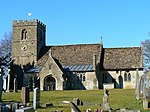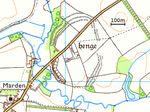All Cannings
Civil parishes in WiltshireEngvarB from June 2016OpenDomesdayVillages in Wiltshire

All Cannings (pronounced "Allcannings") is a village and civil parish in the Vale of Pewsey in the English county of Wiltshire, about 4 miles (6 km) east of Devizes. The parish includes the nearby smaller settlement of Allington. The southern part of the parish lies in the Vale of Pewsey, and in the north the parish extends some 3 miles (5 km) onto the Marlborough Downs and includes Tan Hill, which is (by a small margin) the second highest hill in Wiltshire. Etchilhampton Water, a tributary of the River Avon, forms part of the southern boundary of the parish. Moor Brook flows south through Allington and All Cannings villages to join it.
Excerpt from the Wikipedia article All Cannings (License: CC BY-SA 3.0, Authors, Images).All Cannings
The Street,
Geographical coordinates (GPS) Address Nearby Places Show on map
Geographical coordinates (GPS)
| Latitude | Longitude |
|---|---|
| N 51.354 ° | E -1.901 ° |
Address
The Street
The Street
SN10 3PF , All Cannings
England, United Kingdom
Open on Google Maps











